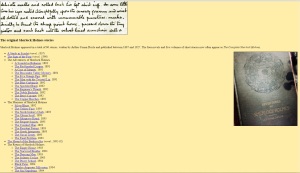A good DH project must presents some features, as we have discussed through this course. I have selected five from these important qualities:
1) Built in collaboration
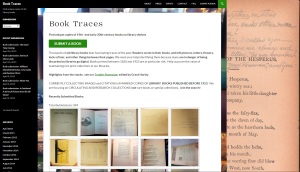
A good DH project is “open-ended”, which means, a lot of scholars or regular people can contribute adding material. Book Traces is a good example. You can easily submit a 19th century book, which contains something on its “marginalia” or objects inside. It is interesting because it is a collective effort to preserve endangered books, which can be discarded by libraries or disintegrated by the time.
This feature makes the project more effective, because its resources can grow in number and quality faster, as a lot of people are helping.
Collaboration also allows scholars to publish their work before finishing it, so they can get feedback from the audience, from other scholars and, then, improve their work. These “work in progress” was really difficult when the projects were paper-based.
2) Be Scholarly developed and oriented to scholars
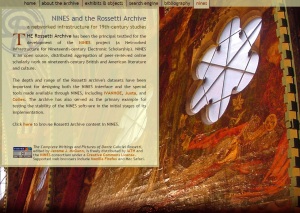
Being a scholarly project means that it has been built based on reliable sources and that the project cites those sources properly. Projects which are developed by Universities or Research Institutes are scholarly. However, everyone can build a scholarly project, if he/she is concerned where he/she gets the data and how he/she cites where it came from.
The Rossetti Archive is a good example of a scholarly project. It has been developed as a basis for the project NINES (Network Infrastructure for Nineteenth-century Electronic Scholarship), which demonstrates that it is built towards scholarly purposes. As it is stated on the website, “the Archive provides students and scholars with access to all of DGR’s pictorial and textual works and to a large contextual corpus of materials(…)” – (The Rossetti Archive, section Home).
3) Integration
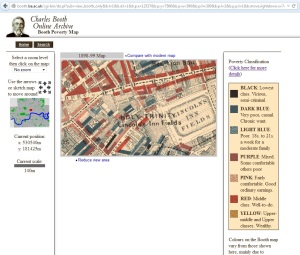 Good DH projects gather a number of objects, maps or even scholarly texts into a single digital interface. This characteristic makes them useful as a scholar or a student can find plenty of information in the same place. Moreover, the digital platforms make possible to conjugate several levels of information onto the same visualization, which would be confusing using printed materials. This is the case of Locating London’s Past, which put together 24 printed maps. Charles Booth Archive is another example. Different colors represent each kind of information, such as crime’s incidence and population through region.
Good DH projects gather a number of objects, maps or even scholarly texts into a single digital interface. This characteristic makes them useful as a scholar or a student can find plenty of information in the same place. Moreover, the digital platforms make possible to conjugate several levels of information onto the same visualization, which would be confusing using printed materials. This is the case of Locating London’s Past, which put together 24 printed maps. Charles Booth Archive is another example. Different colors represent each kind of information, such as crime’s incidence and population through region.
4) Be user-friendly
A good DH project is concerned about how is it easy to a user to figure out by him/herself how the platform works. Being user-friendly involves displaying the information on the screen in an easy way to read and find the data the user is looking for. Locating London’s Past really fulfills this expectation. Besides using design resources to display the information in a clear and readable way, they offer tutorial videos. Besides that, all the tabs follows a coherent organization. 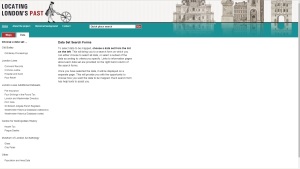 At the top of the page, the user find the two ways of researching – directly onto the map or looking for specific data. Since he decides for data, all the data sets will show up on the left side and the user can pick one up and fill the blanks to find the information he wants.
At the top of the page, the user find the two ways of researching – directly onto the map or looking for specific data. Since he decides for data, all the data sets will show up on the left side and the user can pick one up and fill the blanks to find the information he wants.
Thus, part of being user-friendly is presenting the next DH project’s quality – Design.
5) Design
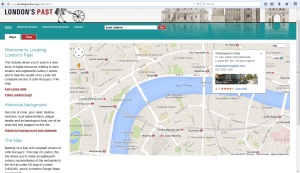 As the article Radiant Textuality explains, “computerization not only vastly increases the amount of accessible information, it enables much greater flexibility in the ways information can be shaped, scaled, and negotiated” (p. 385). Then, a good DH project takes advantage of the design resources to be good-looking, which makes it attractive to the user as well as user-friendly. Using design properly means doing smart choices of colors, different font types and font sizes to organize and categorize different kinds and levels of information. As the image on the right shows, Locating London’s Past is really successful in using design skills. We can identify the use of the variety of font sizes, and a use of colors that is related to the English flag.
As the article Radiant Textuality explains, “computerization not only vastly increases the amount of accessible information, it enables much greater flexibility in the ways information can be shaped, scaled, and negotiated” (p. 385). Then, a good DH project takes advantage of the design resources to be good-looking, which makes it attractive to the user as well as user-friendly. Using design properly means doing smart choices of colors, different font types and font sizes to organize and categorize different kinds and levels of information. As the image on the right shows, Locating London’s Past is really successful in using design skills. We can identify the use of the variety of font sizes, and a use of colors that is related to the English flag.
On the other hand, the archive Sherlockian.net has a lot to improve concerning to design. The use of colors doesn’t seem to have a purpose. The yellow background and the small font type, as well as the organization of tabs and objects is not very readable and doesn’t attract the user. The links are presented in the regular blue color, which also badly affects the whole appearance of the website.
How DH lets scholars ask new questions?
Through DH, scholarly work can be preserved and self-integrated much better than on paper-based instruments. As Jerome McGann affirms in Radiant Textuality, now it is possible to “integrate the resources of all libraries, museums, and archives and make those resources available to all persons no matter where they reside physically” (p. 381). He adds that “electronic publishing permits scholars to present their work in far greater depth and diversity. Essays can present all their documentary evidence as part of their argument (in notes and appendices, or in electronic links to the original documents). They can also exploit fully the use of illustrations and images, including video film clips, as well as audio clips” (p. 384).
Therefore, DH brings up new issues, that couldn’t be seen without the new technologies such as maps, graphics and visualizations. Scholars and students start to search and identify patterns between data, which was really difficult to do with paper based documents. We didn’t have everything together, online, available to access from any place in the world. Now we can compare information at the same screen, and ask questions about what they signify, which trends we can distinguish. Technologies such as N-grams enable us to exercise these skills of discerning trends and patterns. DH projects can function as a beginning of a research, as we discover some data and start looking for the meaning of it.
Furthermore, digital platforms are available to a broader audience and enable critics to dialogue, as well (p. 387). Thus, scholars can discuss and bring different points of view about some data, which means that DH permits scholars to ask new questions.
